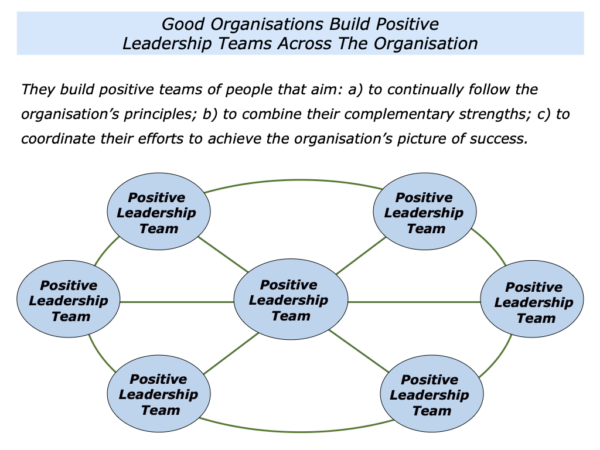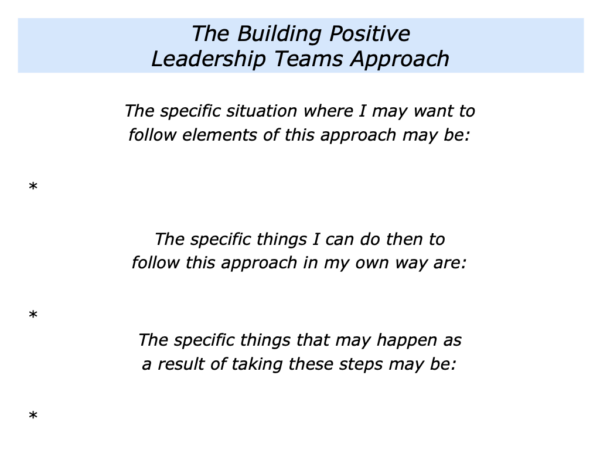
Good organisations encourage their people to focus on the organisation’s purpose, principles and picture of success. Different organisations do this in different ways. Let’s look at one approach.
Some organisations build positive leadership teams at senior level and across the organisation. These teams then aim to follow the principles and make their best contributions towards achieving the picture of success.
Such leadership teams act as positive models. They are often made up of people who are positive and deliver high professional standards. They also demonstrate the following characteristics:
They continually follow the organisation’s principles;
They combine their complementary strengths;
They coordinate their efforts to achieve the organisation’s picture of success.
Such teams create an environment in which motivated people can perform superb work. They then ensure the team follows the principles and makes its best contribution to achieving the organisation’s goals.
Imagine that you are the CEO of an organisation. How can you ensure that people continually focus on the purpose and follow the organisation’s principles?
One approach is to put together good leadership teams at every level of the organisation. They can act as positive models and align their team’s work to achieve the picture of success.
Let’s consider how to build such teams. When doing so, you can select people who are positive, professional and want to lead teams. They then need to demonstrate the following characteristics.
People need to continually follow
the organisation’s principles
The team’s leaders need to act as positive models. The way they behave will strongly influence the culture in their part of the organisation. Bearing this in mind, they need:
To embody the organisation’s principles in their own professional behaviour;
To make decisions by basing these on the organisation’s principles and how these can be translated into action in a specific situation;
To encourage their people to keep focusing on the organisation’s principles and perform superb work.
Imagine that you are considering appointing a new leader – or are focusing on the present leader – and you believe their embody many of the principles. It will then be time to move on to the next stage.
People need to combine
their complementary strengths
Good teams are often made up of people who have complementary strengths. It is common, for example, to have one person who is a visionary and another who is a coordinator. They can then combine their talents to guide the team to success.
One person must be seen to be in charge, of course, and it is important they play to their strengths. They may need to have one or more people around them, however, who compensate for any weaknesses. Tom Rath, an expert on strengths, expressed this in the following way.
Great leaders are not well-rounded but great leadership teams are well-rounded.
Imagine that you are appointing the leader of a team or focusing on the present leader. When doing so, you can aim:
To clarify the specific strengths they have – such as their leadership or management skills – that they can apply when following the principles;
To clarify the complementary strengths they may need to add by getting people who have other leadership or management skills;
To clarify the specific people they may be able to work well with when taking this approach and following the organisation’s principles.
It will, of course, be important to work with the potential or present leader when taking these steps. Imagine that you have put together a leadership team that embodies the principles and have complementary strengths. It will then be time to move on to the next stage.
People need to coordinate their
efforts to achieve the picture of success
Good organisations encourage each team to align their efforts towards achieving the organisation’s goals. They therefore take the following steps. They meet with each leadership team and aim:
To make clear contracts about the team’s contribution – the outcomes they will deliver – towards achieving the organisation’s picture of success;
To make clear contracts about the support they need to achieve the agreed goals;
To make clear contracts about how the team will proactively keep their stakeholders informed about their progress towards achieving the goals.
Imagine that you have made clear contracts with the leadership team about these things. They can then meet together and aim:
To focus on the specific outcomes they are to deliver and translate these into the team’s picture of success;
To focus on how they can follow the organisation’s principles and coordinate their team’s strengths to achieve the picture of success;
To focus on how to communicate this information and make clear contracts about each person’s contributions to achieving the picture of success.
Imagine that the leadership team has taken these steps and are ready to communicate their team. Different leaders will do this in different ways.
One approach is for the leader to say something along the following lines when communicating with their people.
Welcome To Today’s Session.
I am going to start by giving an overview of our organisation’s aims. We will then move on to the part that our team and you and individuals can play in contributing to achieve these goals.
Let’s start with the big picture. You will be aware of most of these things but it can be helpful to remind ourselves of what we are working towards.
The Organisation’s Purpose
The purpose of our organisation is:
* To
The Organisation’s Principles
The key principles we aim to follow to pursue
our purpose and perform superb work are:
* To
* To
* To
The Organisation’s Picture Of Success
The specific goals that the organisation aims to achieve in the
next financial year that will be an expression of our purpose are:
* To
* To
* To
I hope this helps to give the big picture. Bearing this in mind, I now want to focus on how we can align our team’s contribution to achieving the organisation’s goals.
There are certain things we need to deliver for the organisation and we will share these with you. We have also translated these into our team’s picture of success. We can also add other things if you wish.
The Team’s Picture Of Success
The specific goals we aim to deliver
by the end of the financial year are:
* To
* To
* To
The specific principles we aim to follow – include the strategies,
support and actions plans – when working to achieve these goals are:
* To
* To
* To
The specific benefits of achieving these goals – for our
organisation, for our customers and for ourselves – will be:
* To
* To
* To
We want you to take time to reflect and decide if you want to contribute. If so, we will then make clear contracts with you about the outcomes you want to deliver towards achieving the team’s picture of success.
Imagine that the leaders have gone through these steps. They will have given people the big picture and also described the team’s picture of success.
They may then also give their people chance to develop a sense of ownership – with parameters – for adding their ideas. They then make clear contracts with each person about their best contribution to achieving the team’s picture of success.
The leadership team then coordinates sand align people’s efforts to achieve the goals. They often aim to manage by outcomes rather than by tasks. One approach is:
To encourage people to keep focusing on the outcomes to achieve – the picture of success;
To ensure people proactively report their progress towards achieving their agreed contributions to the picture of success;
To produce success stories that highlight how people have followed the principles to do superb work on the way to the picture of success.
They also proactively keep in touch with their key stakeholders – such as the senior team. They keep them informed about the team’s progress towards delivering its agreed goals.
The leadership team continues to focus on the outcomes to achieve. They then ensure the team performs superb work and makes its agreed contribution towards achieving the organisation’s goals.
Great organisations often aim to build such positive leadership teams across the organisation. They then aim to coordinate these teams and channel their efforts to helping the organisation achieve its picture of success.
Let’s return to your own life and work. Looking ahead, can you think of a situation where you may want to follow elements of this approach? How can you do this in your own way?
If you wish, try tackling the exercise on this theme. This invites you to complete the following sentences.







Leave a Reply